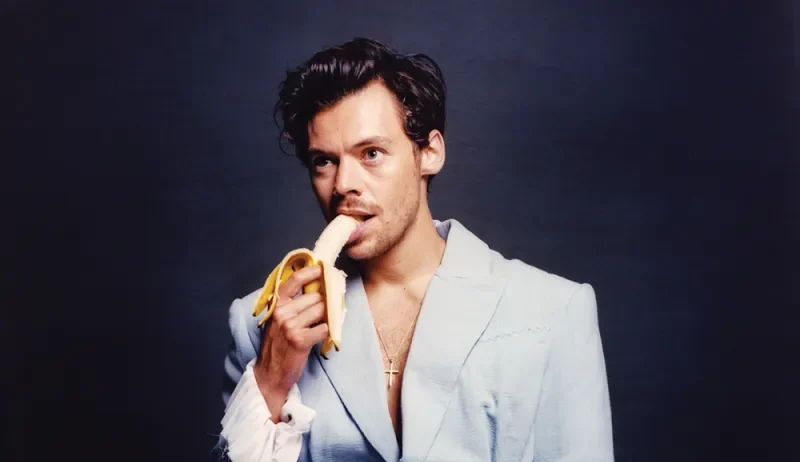On November 13, 2020, Harry Styles made history as Vogue’s first solo male cover. Choosing to wear a dress for the occasion, the singer was heavily criticized by far-right figures like Candace Owens, who feared the “feminization of our men.” She went on X to criticize this choice, posting the phrase “Bring back manly men.” Styles responded to that by posting a picture of him in a light blue tailored suit with ruffles, eating a banana, and the simple caption: “Bring back manly men.”
So, should we bring back manly men? Maybe, but first we would have to define what manliness even means. Because even if we often think of men wearing makeup and dresses as a modern concept, it has actually been happening for thousands of years. In fact, before the Great Male Renunciation of the late 18th century, there weren’t such clear fashion distinctions between genders, and ways to dress were mostly correlated with social classes. The far-right believes that a man’s clothing can diminish his manliness, but it is important to realize that male fashion has always existed outside of gender norms and in fact, there are many different styles that were originally enjoyed throughout history by men before becoming “feminine.”
Ancient Egypt is probably the first sign that men’s fashion had overtaken the practical purposes of clothing, and Egyptian rulers quickly adopted style as a weapon to intimidate and influence those beneath them. As the kingdom evolved from old to new, the most wealthy nobles adopted knee-length tunics and kilts that they accessorized with armlets, bracelets and custom coverings. These were reserved for those who could afford such privileges, and the more powerful and wealthy the man, the more precious the materials he wore. In addition, shaving the head was seen as hygienic and symbolic for egyptians. Wigs were therefore worn by both genders, and reflected the rank of the individual depending on their sophistication. The ancient Egyptians also wore gold and silver jewelry to showcase their wealth and power, but also to protect the body and soul spiritually after death.
Similarly, from the birth of the Roman Republic approximately in 509 BCE, the uniforms of the Roman legions included clothing that was very similar to what we would consider today a skirt. In fact, when the Romans first encountered trousers (“braccae”) in Gaul—the area in modern-day France inhabited by Celtic tribes—they considered them to be a proof of ill health and effeminacy.
Across the globe, elite men wore attire resembling dresses or skirts for decades in antiquity: Egyptians wore schenti, Greeks wore chitons, and Romans wore togas. These were the preferred choice for men who were fighting, building, or farming because they were easy to make and allowed freedom of movement and swiftness while in combat. For these reasons, this skirt-like attire was actually a proof of virility.
In the Middle Ages, Europeans who lived in areas with a moderate climate preferred garments similar to the dresses we know today. Those worn by men were usually shorter at the bottom, and those worn by women often had decorative prints, but otherwise, they were pretty much the same. Wealthy men wore bright colors, embroidery and furs, as masculinity was shown through heraldry and not minimalism. As the tunics shortened, male nobility also wore houppelandes, which were floor-length robes resembling modern-day gowns.
Throughout the Renaissance, these fashion codes accentuated. Wealthy men’s clothing emphasized silhouettes, vibrant colors, slashing (fabric cuts revealing layers), and ruffs. The fabrics were luxurious—velvets, brocades, silks, damasks—and imported into Europe for the nobles. Men’s jewelry became more elaborate and detailed, featuring floral and animal designs.
In the Baroque and Rococo period, from the early 17th century until the late 18th century, men’s clothing became even more extravagant. They wore waistcoats, breeches, and justacorps (long coats), richly adorned. Wigs became the standard for many men in the nobility. Originally, French King Louis XIII began balding prematurely at age 23, and wore a long dark wig, which then spread in the elite of the court wanting to revendicate their social status. Louis XIV then widely popularized the fashion of wigs, wearing very long and voluminous curled wigs created by one of his 48 wigmakers, and arranged in complex patterns with silk threads to create a grandiose effect. His taste for wigs spread beyond French territory, becoming the standard in royal courts all across Europe. Denis Diderot even said, “The monarch’s head of hair became, so to speak, the yardstick of social rank.”
To perfect the look, Louis XIV popularised heeled shoes for men. The earliest known use of heels dates back to 10th-century Persia, where male soldiers on horseback wore heeled footwear to help secure their feet in stirrups, allowing for greater stability and leverage when shooting arrows. Good horsemanship was central to Persian military strategy, and the heel was a functional innovation that enhanced combat efficiency, and therefore linked the footwear with a strong masculine identity.
In the late 16th century, Shah Abbas I of Persia sought alliances with Western European powers, who, eager to emulate the perceived virility and authority of Persian warriors, quickly adopted the heels. These shoes soon became a fashion statement among elite men. In 17th-century France, King Louis XIV further elevated the heel’s cultural significance. He wore heels that added up to four inches to his stature, often adorned with intricate battle scenes and dyed red, a color symbolizing power and martial valor. In 1670, Louis XIV even issued an edict reserving red heels exclusively for his favored courtiers, making footwear a clear indicator of royal privilege. The impracticality of these shoes, particularly in the muddy, unpaved streets of the time, was itself a symbol of status: only those who did not labor or walk long distances could afford such extravagance.
However, this extravagance changed from the late 1700s with the Enlightenment and the Great Male Renunciation. Coined by sociologist John Carl Flugel, the term describes the historical moment when Western men “abandoned their claim to be considered beautiful.” It’s the birth of modern masculinity: sober and utilitarian.
In the Enlightenment period, ideas of reason, democracy, and science emerged. Masculinity began to associate itself with rationality and stoicism, rejecting what was viewed as the “irrationality” of ornaments and excesses. The courtly, aristocratic style became symbolic of the privileges of the old order. Revolutionaries wore simple trousers, and plain clothing reflected moral virtue and republican ideals. Rich colors like crimson, emerald, gold, or royal blue vanished from men’s wardrobes, just like embroidery, lace, silk, and jewels. Black, gray, navy, and brown became the masculine palette. Men stopped wearing wigs, which had been the standard for centuries, and was now associated with vanity and aristocracy. Hair was cut short, and neat grooming replaced elaborate hairstyles. Heeled shoes, once a symbol of masculine authority, also disappeared from men’s fashion. Women became the bearers of beauty, as men gave up adornment. Beauty and style were now “feminine” realms as men’s fashion emphasized virtues of discipline, utility, and modesty.
It is also at this time that men stopped wearing makeup. They had been beautifying themselves since 50,000 BCE, as archeologists discovered minerals in a Spanish Neanderthal encampment that was used similarly to the foundation and blush we know today. This was followed by the Egyptians’ kohl eyeliner, green malachite shadow, and lip and cheek stains made from red ochre as well as the Roman men who were known to apply red pigment to their cheeks, lighten their skin with powder, and paint their nails with pig fat and blood. More globally, the royalty from the 16th century until the mid-1800s valued ghost-white powdered skin, used to signal wealth, as noblemen did not work outdoors like the peasants, so their skin was not altered by the sunrays. They wore white face powder, rouge and even mouches (fake beauty marks). In an era where bathing was infrequent, men also carried pomanders and scented gloves to serve as perfume. It is only the arrival of the Great Male Renunciation that resulted in the abandonment of cosmetics, as definitions of masculinity narrowed, creating strong associations between makeup, vanity, femininity, and the Devil.
The vision of male attire as sober and utilitarian that developed from the 18th century remains the most common one today. However, the 1960s and 70s also brought another aesthetic for men, through the hippie and glam rock movement. Long hair, makeup, velvet and platform shoes were popularised again by some pop culture icons like David Bowie and Prince. The crop top also emerged in the 70s. Today it is mostly worn by women and queer individuals, but it was originally a male trend, born in the locker rooms of American football matches. Football players and athletic stars began curing their t-shirts above the navel in order to better distribute their body heat. It soon spread, with weightlifters adopting the trend as a way of getting around gym rules about being shirtless. The crop top was, at its core, a product of the hyper-masculine athlete culture of the time.
Brands like Nike jumped on the trend to produce their own cropped shirts, which was depicted on the big screen with Johnny Depp sporting a cropped football jersey in A Nightmare on Elm Street, or Will Smith in The Fresh Prince of Bel-Air wearing a crop top as well. Prince wore a crop top on stage, Dennis Rodman wore a crop top on the red carpet, and Mark Wahlberg wore a crop top in an advertisement for Calvin Klein.
Overall, most items of clothing or makeup that are today considered feminine or “gay” when men wear them, were initially conceived for and worn by men. From the heeled shoes, tunics, and wigs, to crop tops and platform shoes, fashion has never been more gendered than from the 19th century onwards. When we take a look at the history of male clothing, the idea that skirts or elaborate clothing make a man “unmanly” quickly falls apart. Some of the most powerful and revered men in history wore garments that today might be mocked as “feminine.” These men were not mocked or diminished for their fashion choices, they were feared, admired, and emulated. The absurdity of our modern judgments becomes clear when we realize that we’ve flipped centuries of history, allowing rigid, industrial-era norms to define masculinity in the narrowest terms possible. To call a man weak for wearing what his ancestors proudly ruled empires in is not just historically ignorant, it’s simply insecure.
Today, gender norms continue to trap individuals in rigid, outdated roles where every gesture, item of clothing, or accessory is scrutinized through the lens of conformity. Men are still widely discouraged from expressing themselves beyond what society deems “masculine”: wearing pink, putting on nail polish, crying, or simply deviating from the model of the stoic, austere man remains taboo in many circles. This constant policing has nothing to do with nature or biology, it’s the result of a social construct reinforced by centuries of patriarchal ideology. And the irony is glaring: these norms claim to protect men, but in reality, they rob them of freedom. They stifle creativity, limit personal expression, and perpetuate an irrational fear of femininity, as if being associated with anything “feminine” somehow makes a man less of a man.
So when Candace Owens claims that we should bring back manly men, I say let’s do so. Let men wear whatever they like since, ultimately, clothes are made to experiment and have fun with. We stopped forcing women to wear skirts and dresses, how about we stop imposing gender norms in fashion altogether?
Other posts that may interest you:
- Femmes d’exception : les succès qui ont marqué 2024
- The “Crazy Fangirls” Probably Made Your Favorite Artist
- With the AWSN, Has the Time Finally Come for Women’s Sports ?
- Do You Slay?
- The Eras Tour : La tournée de tous les records tire sa révérence
Discover more from The Sundial Press
Subscribe to get the latest posts sent to your email.





